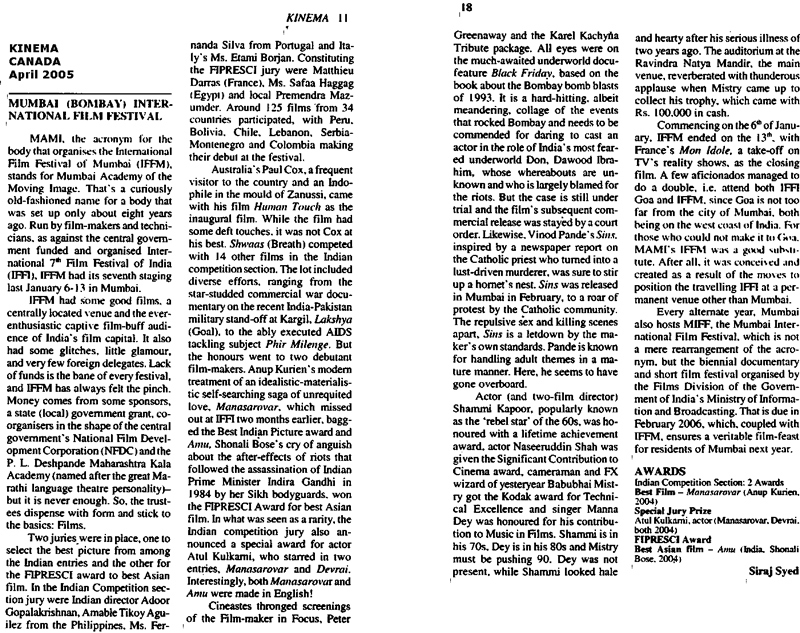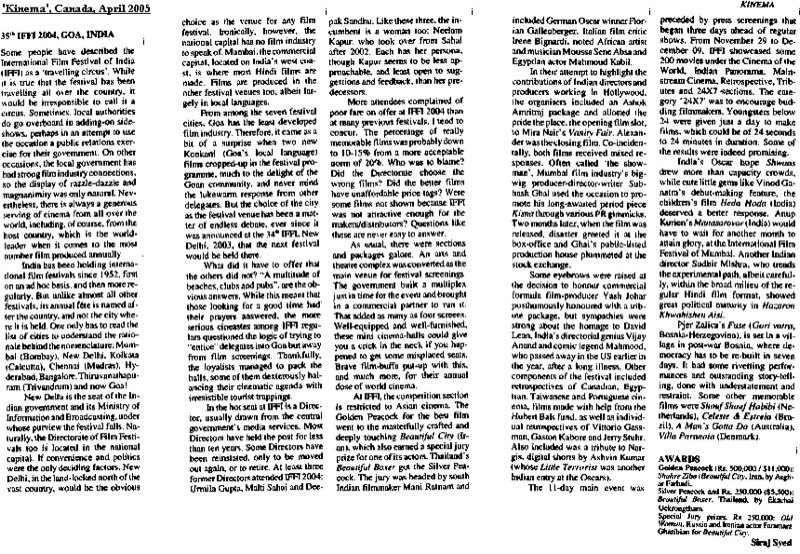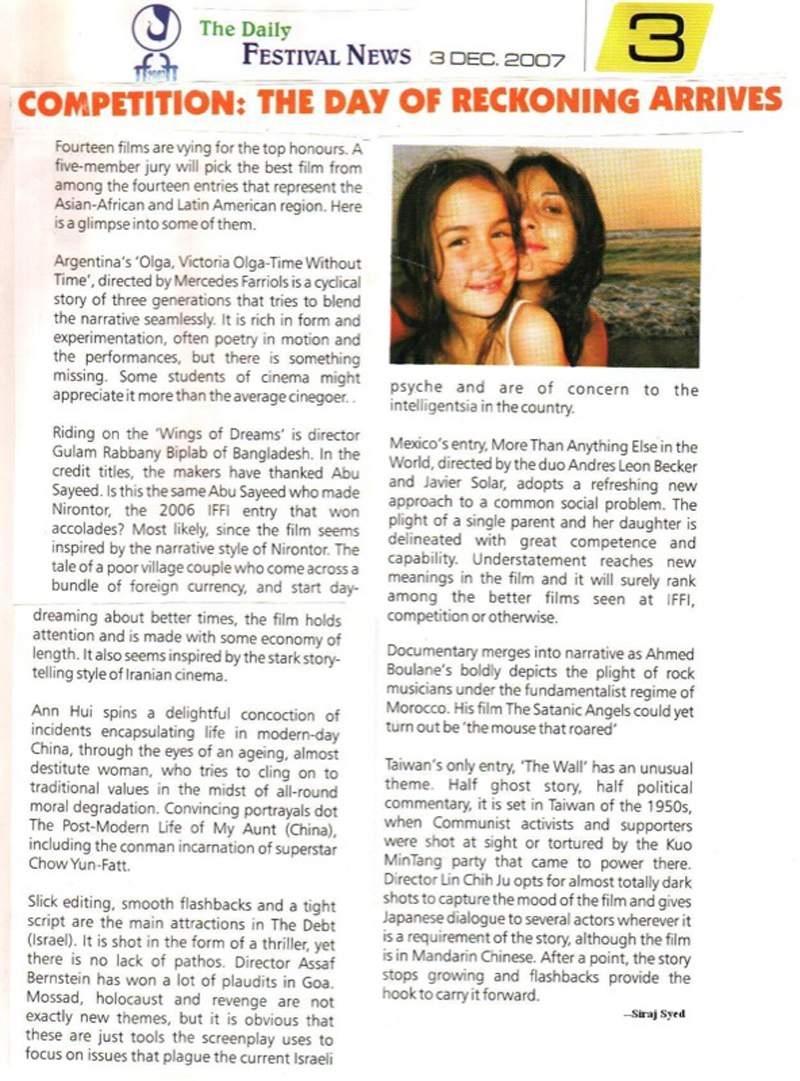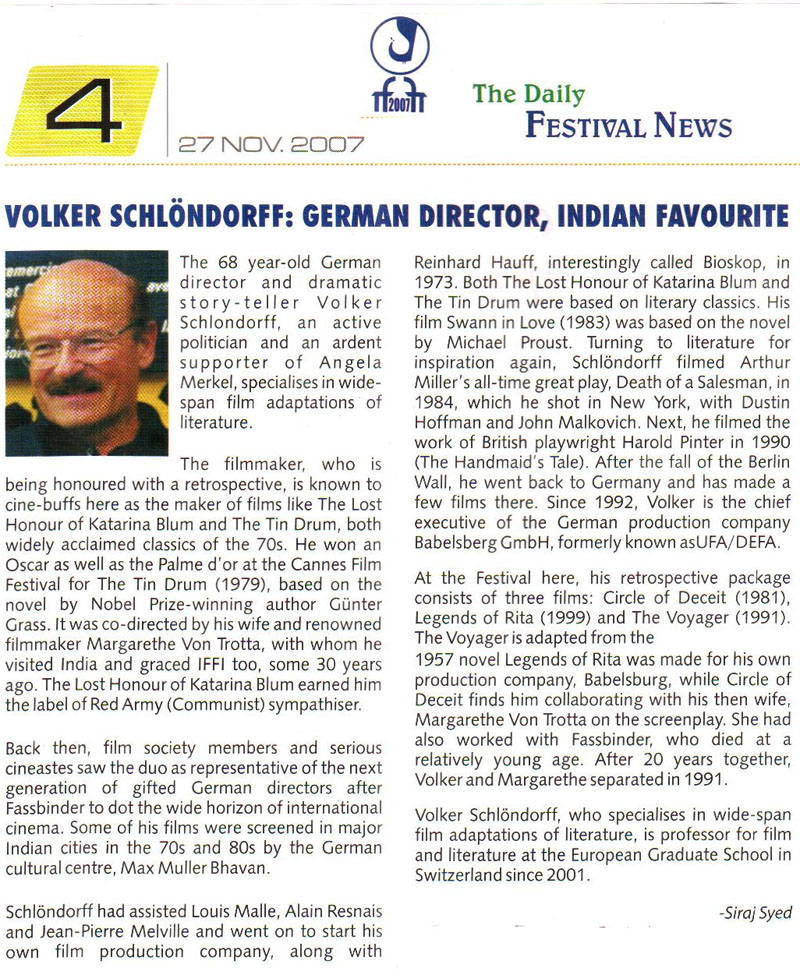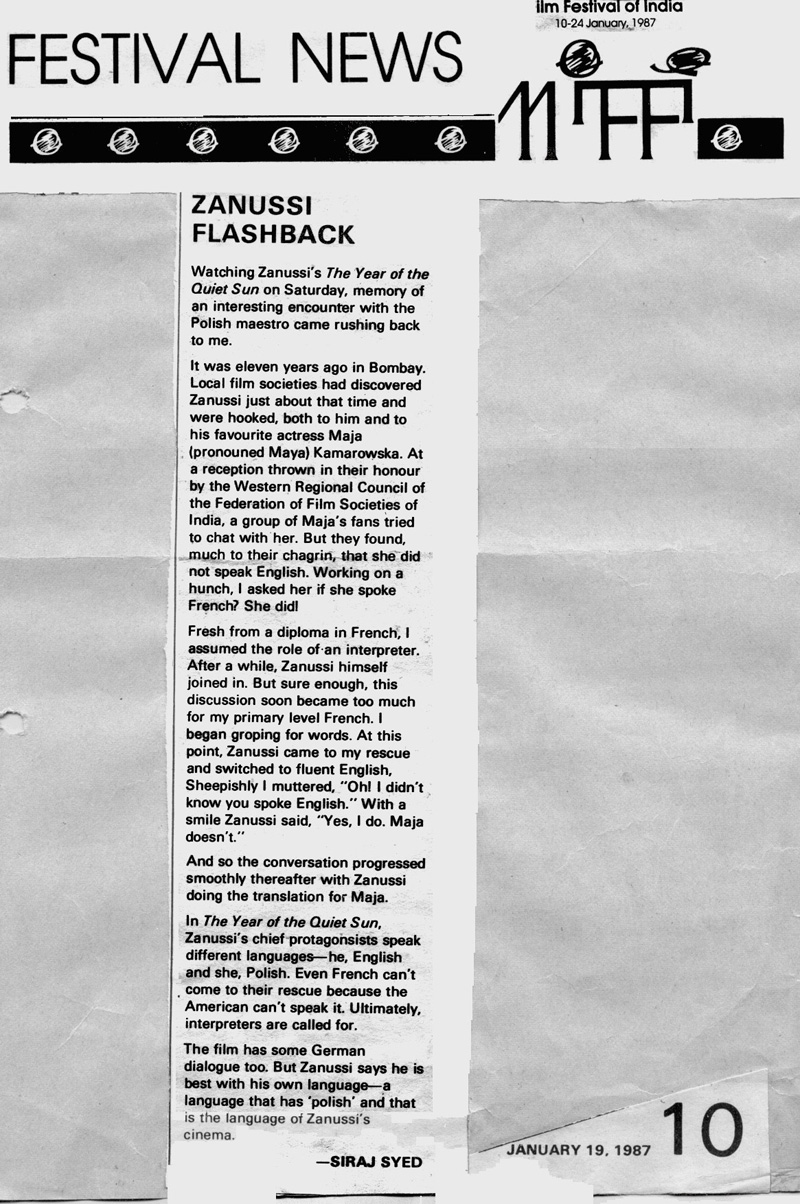|
|
||
|
Pro Tools
FILMFESTIVALS | 24/7 world wide coverageWelcome ! Enjoy the best of both worlds: Film & Festival News, exploring the best of the film festivals community. Launched in 1995, relentlessly connecting films to festivals, documenting and promoting festivals worldwide. We are sorry for this ongoing disruption. We are working on it. Please Do Not Publish until this message disappears. For collaboration, editorial contributions, or publicity, please send us an email here. User login |
Siraj SyedSiraj Syed is the India Correspondent for FilmFestivals.com and a member of FIPRESCI, the International Federation of Film Critics. He is a Film Festival Correspondent since 1976, Film-critic since 1969 and a Feature-writer since 1970. He is also an acting and dialogue coach. @SirajHSyed  Aarohi, Review: Play about decadence, women’s empowerment and good v/s evil
Aarohi, Review: Play about decadence, women’s empowerment and good v/s evil A Kinkini Production, Aarohi had its premiere show on Saturday, 29th June, at St. Andrew's Auditorium, Bandra, Mumbai. It is an ode to the classical Indian dance form of kathak and its exponents, weaved into a narrative that brings in other societal evils into focus, like the maltreatment of women, equality of all citizens and moral values, like truth and honesty. During the 19th and 20th century, there was a tradition of kothas and tavaifs, where singers, musicians and dancers exhibited their art before an audience, usually in a homely setting. A kotha was the name given to the place, and a tavaif, or courtesan, was the lead singer-dancer. On invitation or summon, her troupe also performed before royalty or at social occasions. The troupe was paid for its services, either as voluntary gifts/tips, or on an agreed amount basis. These tavaifs followed gharanas (houses) of traditional art, and propagated dance and music forms of a particular style. Some of them married their patrons, while some others entered into long-term alliances and were humiliatingly called rakhaels (keeps), as their benefactors were already married. On the plus side was the fact that rich families and royalty sent their sons to these places to learn things like courteous behavior and cultural nuances. Of course, they were perceived as seductresses with loose morals, so they could not hope to have normal marriages. Aarohi, a kathak dancer, born in the rich tradition of the Lucknow gharana, is the daughter of Pandit Banwarilal and Firozy Begum, a Hindu and a Muslim respectively. A cheerful, bubbly, innocent girl and a fiery dancer, she falls in love with the debonair Inderjeet, also a kathak dancer, who has come from Jaipur, to learn under her father. He professes his love for her, and reveals that he has been in love with her ever since he saw her perform abroad, many years ago. Somehow, he wins her over. Life takes an ugly turn after she marries Inderjeet, and finds herself a victim of his vile ways. Firstly, his father rejects her and throws the couple out. Secondly, Inderjeet takes her to Bombay, where he, to run the kitchen, makes her dance in hotels, on film songs, something considered undignified by kathak purists. Hiding this fact from her father, she finds herself torn between her guilt, and the deception by the man she loved. Moreover, Inderjeet and Aarohi live with Chandra Bhabhi (sister-in-law, brother’s wife), the wife of a friend of Inderjeet, who stays abroad for long periods. Chandra is a voluptuous woman, fond of alcohol, and seduces Inderjeet right under the nose of Aarohi. When she discovers she is pregnant, she cannot take it anymore, and calls her father to take her back to Lucknow. But Inderjeet is not done yet. During the 20th century, hundreds of films were made and an equal number of plays staged on this basic premise. They all traced the plight of a courtesan who married a patron and left her family to live with him, either separately or with her in-laws, and the living hell she was subjected to. Aarohi does a slightly different take, by way of getting her married to a fellow student. Also, the setting is in Mumbai of the pre-80s, as the city is referred to as Bombay, its old name. There is no suggestion that the protagonist is a tavaif. On the contrary, Banwarilal Bhatt runs a school that trains students in the intricacies of the Lucknow gharana as a purely academic institution. That is an interesting difference. Also, the entry of a male student from the Jaipur gharana to learn from a Guru of the ‘rival’ Lucknow gharana is something novel. Teachers usually avoid taking in pupils from other gharanas, and some teachers, like Mumbai-based Roshan Kumari of the Jaipur gharana, do not take in male pupils at all. Having introduced these two major divergences, the writer-director, Salim Akhtar, then works on allotting the parts in ways that may either be the result of limited talent available or just a form of experimentation. The older Aarohi is on the stage for almost the entire play, sometimes walking along the space between the first row and the stage, often doing nothing or keeping herself busy with humming and gestures that suggest she is practicing her art. There is another actress portraying the teens-to-twenties Aarohi, who is then given the part of Aarohi’s daughter, Raagini. Impressario Ajmera is played by the same actor who doubles up as Inderjeet’s father, and one of the actress playing Chandra Bhabhi also dons the costume of Inderjeet’s mother. These moves do not add any special quality to the play, as an actress playing her own daughter at around the same age has no novelty. Again, there was no need to cast the same actor in the roles of Ajmera and Inderjeet’s father. Although directors do tend to make their actors stand much more than necessary, to make it convenient for the directors to give them moves, and do ‘blocking’, it becomes awkward to find almost all actors standing almost all the time in Aarohi, when they should have been sitting. The ease with which Inderjeet garners success and fame defies logic, given his mediocre talent, as clearly enunciated more than once. In order to avoid the necessity of showing a baby of age 0-2 years, the script abjures showing her altogether, even using a symbolic doll or a piece of cloth wrapped around in the shape of a baby. It is not easy showing a real baby, but surely some symbolic way was possible, with the help of baby sounds. Young Aarohi’s age is never specified, though one is curious to know how old was she when Inderjeet first saw her perform in Sweden and fell head over heels for her. Inderjeet proving to be a he is a scalawag and sinking deeper into the morass of his own machinations is too predictable and linear to hold interest. Ragini making a beeline for Bombay, to meet her father, after her return to Lucknow from New York, against the express will of her dear mother, as an 18-year old is hard to digest, as is her bringing home her dance professor, all the way from America, unannounced, to live with the family. Two years under production, and yet the play is surely under-rehearsed, what with many actors forgetting their lines. Sanjay Bhatiya, who played the professor, was the chief culprit, though others were not far behind. We could hear whispered prompting noises from back-stage on more than one occasion. Guess like the art of kathak, a play with so much of kathak in it: padhant, tatkaar, chakkardaar, etc., needs to be rehearsed for 4-5 years, before a performance is staged. Of course, I do realise that such a long gestation period may be impractical for a play. There were some lighting issues too, and the ambitious design was not easy to execute. Costumes were eye-pleasing.
Dhaani Jhankhal, Gautam Rode and Ravi Jhankhal//On the right in the other picture, at the top, is Meeta Vashist Looking for positives, veteran film and TV actors Meeta Vasisht and Ravi Jhankhal acquitted themselves well, though Meeta overly underplayed most of her scenes. Part of the cause was the fact that she was asked to do pretty little. Ravi’s paralytic attack was very realistic, while his almost complete recovery over time was a welcome bit of writing. Normally, once somebody has had a paralytic attack, he or she is shown on a bed or wheelchair for the rest of the play, and is unable to speak thereafter, save incoherent mumbling. One scene, wherein all three persons are having tea, and one of them, Aarohi, asks the professor whether he would like some tea, said a lot about the trauma she was going through. Ravi’s cries of anguish being that of a Muslim add to the integrational theme of the play. Both he and Meeta must have worked very hard to get the kathak readings right, with Meeta even enacting the dance form. Gautam Rode as Inderjeet blends well as the awkward dancer. How he managed to get a letter of recommendation from a revered guru is another matter altogether. He is not fully convincing when he turns to his wicked, wicked ways, although he tries hard, and the gruff voice as the older man comes across as a falsetto. This all the more noticeable since Aarohi and Banwarilal, his contemporary, and a generation his senior, respectively, speak normally. Dhaani Jhankal as young Aarohi and Ragini is captivating, with her English as smooth as her Hindustani. Although it would be unfair on my part to assess the merits of the dancers, they did appear to do a decent job, including Meeta, Dhaani and Dr. Deepti Dyondi (who also played Chandra). Stereo-typed as Chanda, with humming ‘Mera naam chin chin choo’, a 50s’ film hit song, she shows off her curves rather uninhibitedly. Himanshu Gokani impresses more as Ajmera than as Inderjeet’s father. As his mother, the actress is hopelessly type-cast. Dialogue (Era Tak) is generally functional, with a few clap-trap lines and an equal number of clichés. Being an ode to kathak and to women empowerment, the play ends on an optimistic note, and good triumphs over evil in the long run. Ragini’s bold gesture at the end draws applause and tears at the same time. Notably, the institution of the kotha is now almost confined to history, and if it still exists in some parts of the country, in some form, it will most likely be a sign of an institution that lost out to decadence. Cast: Meeta Vasisht, Ravi Jhankal, Gautam Rode, Dhaani Jhankal, Dr. Deepti Dyondi, Himanshu V Gokani, Sanjay Bhatiya Story, Design & Direction: Salim Akhtar Choreography & Costumes: Anita Ordia Writer: Ashok Mishra Dialogues: Era Tak Music Director: Kajal Ghosh *Salim Akhtar has designed and directed over 30 plays. He directed TV Commercials for advertising guru, late Alyque Padamsee, for Duroply, sanitary napkins and for the product launch of Emami Madhuri Secrets. He has also directed music video albums of Jagjit Singh, Nusrat Fateh Ali Khan, Lata Mangeshkar, Falguni Pathak, Shibani Kashyap, and many others. Akhtar has been involved in various events, national and international, as Technical and Event Director, with over 3,000 shows to his credit. *Anita Ordia is a well-known name in the field of kathak today. She is the disciple of Padma Vibhushan (India’s highest civilian honour) Birju Maharaj, as well as Late Pandit Durga Lal Jee, thus having received training in both Lucknow and Jaipur Gharanas respectively. She is the founder of Kinkini, an academy for performing arts, in Rajasthan . She has performed in various prestigious festivals in India as well as abroad, like the Albert Hall festival, Camden Festival London, Indian Festival at South Korea and the centers of performing arts in Japan, Holland, East and West Germany, Belgium, Singapore, Hong Kong, Thailand, Malaysia, Middle East and England, besides winning several prestigious awards. 01.07.2019 | Siraj Syed's blog Cat. : Anita Ordia Ashok MIshra Birju Maharaj Dhaani Jhankhal Dr. Deepti Dyondi Era Tak Gautam Rode Himanshu Gokani jaipur Kajal Ghosh Lucknow Meeta Vasisht Pandit Durga Lal Salim Akhtar Sanjay Bhatiya FILM
|
LinksThe Bulletin Board > The Bulletin Board Blog Following News Interview with EFM (Berlin) Director
Interview with IFTA Chairman (AFM)
Interview with Cannes Marche du Film Director
Filmfestivals.com dailies live coverage from > Live from India
Useful links for the indies: > Big files transfer
+ SUBSCRIBE to the weekly Newsletter DealsUser imagesAbout Siraj Syed Syed Siraj Syed Siraj (Siraj Associates) Siraj Syed is a film-critic since 1970 and a Former President of the Freelance Film Journalists' Combine of India.He is the India Correspondent of FilmFestivals.com and a member of FIPRESCI, the international Federation of Film Critics, Munich, GermanySiraj Syed has contributed over 1,015 articles on cinema, international film festivals, conventions, exhibitions, etc., most recently, at IFFI (Goa), MIFF (Mumbai), MFF/MAMI (Mumbai) and CommunicAsia (Singapore). He often edits film festival daily bulletins.He is also an actor and a dubbing artiste. Further, he has been teaching media, acting and dubbing at over 30 institutes in India and Singapore, since 1984.View my profile Send me a message The Editor |



















